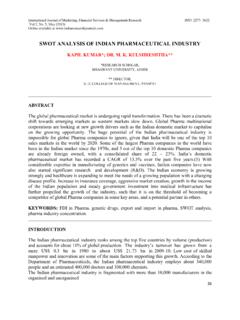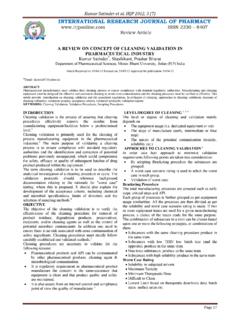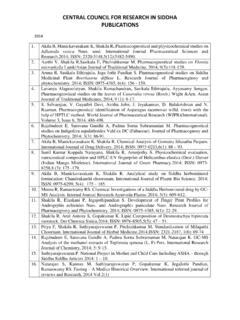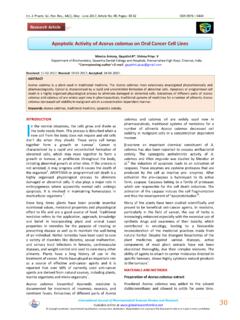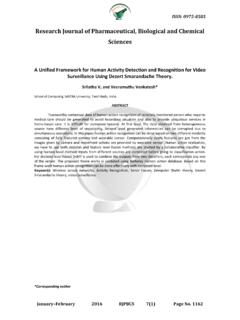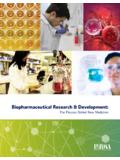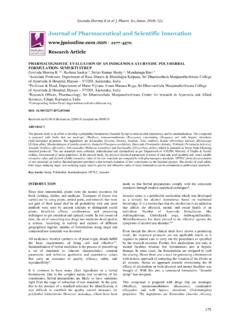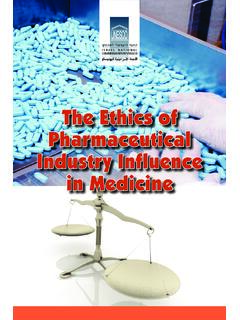Transcription of Nigerian Journal of Pharmaceutical and Applied Science ...
1 Nigerian Journal of Pharmaceutical and Applied Science research , 7(3): 25-32, September 2018 (ISSN 1485-8059 Available at ) Usifoh et al., Prevalence and Knowledge of Harmful Effects of Alcohol Consumption Page 25 NIJOPHASR Prevalence and Knowledge of Harmful Effects of Alcohol Consumption among Pregnant Women in Edo and Delta States, Nigeria. Stella F.
2 Usifoh1*, Isabel N. Aika1, Oghenemine N. Ogugu1 and Valentine U. Odili1 1 Department of Clinical Pharmacy and Practice, Faculty of Pharmacy University of Benin, Benin City, Nigeria. ABSTRACT Alcohol consumption during pregnancy is a burden to public health as a common visible effect of alcohol use is fetal alcohol syndrome. The study determined the prevalence of alcohol consumption in pregnancy and knowledge of its harmful effects among the women in parts of Edo and Delta states of Nigeria. A cross-sectional study of 600 pregnant women with a structured questionnaire on demographics, consumption of alcohol and knowledge of the harmful effects on fetus were assessed.
3 Many respondents 42% were within 21-29 years, married (90%) and had tertiary education. More than half of the respondents 385( ) have taken alcohol, 216(36%) before or 176( ) during present pregnancy. Reasons given by 47 ( ) were to prevent spitting, nausea and vomiting, while twenty four (4%) of the respondents believed alcohol makes the baby small for delivery and 34 ( ) believed it makes them strong for daily activities. However, ( ) were unaware of its harmful effects and only 22 ( ) knew about fetal alcohol syndrome. Prevalence of alcohol intake is high and is more in Delta than Edo State. Many of the pregnant women are unaware of the detrimental effects of alcohol to fetus especially fetal alcohol syndrome.
4 There is need for educational campaigns on abstinence of alcohol among women of child-bearing age. Keywords: Alcohol consumption, pregnancy, Fetal alcohol syndrome, harmful effects. INTRODUCTION Alcohol use is widely accepted around the world and it is a common feature of social gatherings. In Africa and Nigeria in particular among others indications, it is also used as an aphrodisiac, to treat cold, for oral hygiene and a vehicle in herbal medicine preparations (Gumede, 1995; Brisibe and Ordinioha, 2011). Alcohol use is an important factor in a woman s health risk profile. Harmful patterns of alcohol consumption are strongly associated with increased mortality and morbidity including mental health disorders such as substance dependence, depression and physical morbidities such as breast cancer and HIV infection (Piazza et al.)
5 , 1989; Priscilla et al., 2011). A population-based survey has documented rates of alcohol use and harmful drinking among African women that raises concern, including episodic binge drinking and regular high consumption. Prevalence of alcohol use in the past year among women was estimated at 30% in Botswana and 47% in Namibia. Heavy drinking was found in 38% of women currently drinking in Nigeria and 20% among current female drinkers in Uganda (May et al., 2009). Alcohol use during pregnancy is common and a major public health concern considering its effects on the developing fetus. Although women who drink during pregnancy are at risk of having a child with Fetal Alcohol Spectrum Disorder (FASD), prevalence and incidence rate have not been documented in Nigeria.
6 Women who drink during pregnancy are not a homogenous group, and include women that are alcohol dependent, women who abuse alcohol on an episodic basis, and women who drink infrequently or regularly at low amounts (Viljoen et al., 2005). Although damage to the fetus is more likely to occur with high quantity of alcohol and of particular risk is the pattern of drinking in which high quantity of alcoholic (>5 units) drinks are consumed on one occasion which is referred to as binge drinking. Irrespective of the level of consumption, alcohol intake during pregnancy can cause FASD, the most popular among these being the Fetal Alcohol Syndrome (FAS) which are a group of conditions that can occur in a person whose mother drank alcohol during pregnancy.
7 Problems may include abnormal facial features, such as a smooth ridge between the nose and upper lip (this ridge is called the philtrum) small head size, short height, small eyes, low body weight, poor coordination, low intelligence, behavioural problems, and problems with hearing or seeing (CDC, 2018). Corresponding Author: +2348056226668 Nigerian Journal of Pharmaceutical and Applied Science research , 7(3): 25-32, September 2018 (ISSN 1485-8059 Available at ) Usifoh et al., Prevalence and Knowledge of Harmful Effects of Alcohol Consumption Page 26 NIJOPHASR As reported by the American Academy of Pediatrics in 2015, no quantity of alcohol consumption in any trimester is safe.
8 Authors said in the report that first trimester drinking versus no drinking produces 12 times the odds of giving birth to a child with FASD, first and second trimester drinking increases FASD odds 61 times and drinking in all trimesters increases FASD odds to 65 times. The entire continuum of effects is estimated to represent at least 20 to 50 per 1,000 live births in certain urban areas of the United State and some Western European countries. Although recent data indicate that FASDs are more common in some populations throughout the world than previously thought, certain regions of South Africa are reported to have the highest measured prevalence rates of the disorder in the world (Cornelius et al.)
9 , 1997; Viljoen et al., 2005). Predictors of alcohol consumption during pregnancy include younger age, (although older pregnant women also use alcohol) non-Hispanic background, education exceeding high school, and employment (Ebrahim et al., 1998; Floyd et al., 1999; Chang et al., 2005). Other studies have shown that alcohol consumption before pregnancy predicts antenatal consumption as well (Day et al., 1993). A partner s health habits and knowledge may influence specific behaviors during pregnancy, drinking by men may influence maternal alcohol consumption (Leonard and Mudar, 2003). Alcohol consumption during pregnancy is higher among African women compared to other parts of the world (Adusi et al.
10 , 2012). In a systematic review on alcohol exposure among pregnant women in Sub-Sahara Africa, Nigeria had higher per capita alcohol consumption than South Africa despite the limited data from Nigeria, thus Nigeria may likely have more cases of FAS (May et al., 2009; Culley et al., 2013). Few studies have been conducted on alcohol use during pregnancy in Nigeria, two from the South-Southern region and one from the south Eastern region ( Abasi Obong et al., 2012; Ordinioha and Brisibe, 2015; Onwuka et al., 2016). This study aims at determining the prevalence of alcohol consumption in pregnant women in two states in Southern Nigeria, and to ascertain knowledge of pregnant women on the harmful effect of alcohol on the fetus.
